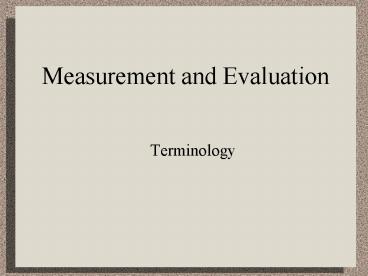Measurement and Evaluation - PowerPoint PPT Presentation
1 / 32
Title:
Measurement and Evaluation
Description:
Krebs Cycle, Electron Transport Chain, Beta Oxidation, Measurements. Submaximal VO2 ... torr. Measurement and Evaluation. Statistical Terms. Statistics ... – PowerPoint PPT presentation
Number of Views:669
Avg rating:3.0/5.0
Title: Measurement and Evaluation
1
Measurement and Evaluation
- Terminology
2
Anaerobic
- Anaerobic Energy Systems
- ATP-PCr Phosphagan
- Glycolytic Lactic Acid
- Maximal anaerobic energy production 0-90 seconds
3
Anaerobic Tests
- Vertical Jump
- Stair-Step Test
- Sprint Tests
- Wingate Cycle Test
- Blood Lactate
4
Muscle Test
- Grip Strength
- 1-RM Test
- Muscle Endurance
- Sit-Ups Test
- Push-Ups Test
5
Flexibility
- Static (e.g. Sit and Reach)
- Dynamic (e.g. Range of Motion)
6
Aerobic
- Aerobic Energy System
- Oxidative Phosphorylation
- Krebs Cycle, Electron Transport Chain, Beta
Oxidation, - Measurements
- Submaximal VO2
- calories
- estimate VO2max
- VO2max
- Basil Metabolic Rate
- Resting Metabolic Rate
7
Cardiovascular
- Blood Pressure
- Heart Rate
8
Body composition
- Measurements
- Fat mass
- Fat free mass
- Body mass index
- Waist to hip circumference
- Tests
- Skin Fold Calipers
- BIA
9
Terminology
10
Mass
- Mass is the quantity of matter in an object
- Under normal conditions mass equals weight
- Units of mass
- Gram
- Kilogram
- 1 pound 2.2 kilograms
11
Force
- Force is that which changes the state of motion
in matter e.g. muscular activity generates force - Units
- Newton The unit of force required to accelerate
a mass of one kilogram one meter per second per
second. - Kilogram is also used
- 1 Newton 0.1 Kg
12
Work
- Work is force applied over a given distance
- Work force x distance
- Units
- kg . m
- N . m
- Joule
- 1 kgm 10 Nm 10 J
- Work can be positive (e.g. concentric
contractions) or negative (e.g. eccentric
contractions).
13
Velocity
- Velocity is speed
- Velocity distance / time
- Units
- mph
- m/min
- m/sec
- 1 mph 26.8 m/min 1.6 km/hr
- 1 m/min 0.04 mph
14
Power
- Power work / time or the rate of work
- Units
- watts (W)
- joules per second
- kgm/min
- Nm/min
- Horsepower
- 1 W 6.12 kgm/mi 0.1019 kgm/s 1 J/s 60
J/min 0.060 kJ/min 1 Nm/s 60 Nm/min
15
Energy
- Energy is a measure heat production
- Units
- calorie
- kilocalorie (kcal)
- joule
- 1 kcal 1000 calories 4.184 kJ 4184 J
- VO2 is an indirect measure of energy where 1.0
liter/min 5 kcals.
16
Temperature
- Units
- Fahrenheit
- 32 º to 212 º
- ºF (1.8 x ºC) 32
- Celsius
- 0 º to 100 º
- ºC 0.56 (ºF 32) or (ºF 32) / 1.8
- Kelvin
- 273 ºK 0 ºC 32 ºF
17
Barometric Pressure
- Pressure of the atmospheric air
- Units
- mm Hg
- torr
18
Measurement and Evaluation
- Statistical Terms
19
Statistics
- Organizing, describing, and analyzing
quantitative data - Prediction outcomes
20
Variable
- Independent variable (X)
- Manipulated or changed e.g. age, gender, etc.
- Dependent variable (Y)
- Measured e.g. heart rate
21
(No Transcript)
22
Differences
- t- Test
- Analysis of Variance (ANOVA)
23
Relationships
- Correlation coefficient (r)
- May describe the accuracy of the test
- May describe how one variable relates to another
predictor - Direct or positive
- Indirect or negative
24
r -0.44
25
Level of Significance
- p values
- Typical level of significance is set at p lt 0.05
26
Other Terms
- Reproducibility
- Test-retest minimum is typically 0.70 or 0.85
- Objectivity
- Reproducibility with other administrators or
testers - Validity
- Measures what it claims to measure
27
Prediction
- Regression line
- Regression equation
- Standard error of estimate (SEE)
- The amount of error that can be expected in a
predictive score - If SEE 5 kg for a predicted weight of 40 kg
then 68 of weights will be between 35 kg and 45
kg.
28
(No Transcript)
29
Norms
- Mean
- Standard deviation
30
Standard Deviation
- One standard deviation away from the mean in
either direction on the horizontal axis (the red
area on the above graph) accounts for somewhere
around 68 percent of the people in this group.
Two standard deviations away from the mean (the
red and green areas) account for roughly 95
percent of the people. And three standard
deviations (the red, green and blue areas)
account for about 99 percent of the people.
31
Types of tests
- Field tests
- Large groups
- Screening
- Not good for research tools
- Lab tests
- More control
- Less practical
32
(No Transcript)































